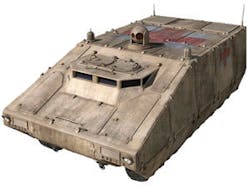By Courtney E. Howard
WASHINGTON - U.S. Army officials have restructured the Future Combat Systems (FCS) program to modernize the current force, while also providing the future force with advanced technology.
As a result of the restructuring, four of the 18 systems in the FCS program have been delayed, and the fielding of systems extended five years through 2015. These FCS changes will eliminate $3.4 billion from its budget over the next five years, says Army Maj. Gen. Jeffrey A. Sorenson, deputy for acquisition and systems management.
The Army’s FCS program was originally designed as a system of 18 individual systems tied into a network and the soldier, referred to as 18+1+1. The overall FCS program now stands at 14+1+1.
The medical vehicle component of the Army’s Future Combat System, shown above, is one of the 14 surviving parts of the program.
“We’ve had to go through a very difficult period here, in terms of making sure we can modernize as well as support the current operations and the current force,” Sorenson says.
Two of the four unmanned aerial vehicle (UAV) platforms were deferred to later in the program, as was the armed robotic vehicle system and intelligent munitions system.
FCS remains the largest modernization program for the Army, despite the cuts and deferments. The program is on time, on cost, and still the number-one priority of Army leadership, says Sorenson.
The restructured FCS 14+1+1 configuration
The FCS Network
The Soldier
Unattended Ground Sensors
Non-Line-of-Sight Launch System
Class I Unmanned Aerial Vehicle
Class IV Unmanned Aerial Vehicle
Small Unmanned Ground Vehicle
Multifunctional Utility Logistics/Equipment
Infantry Carrier Vehicle
Non-Line-of-Sight Cannon
Non-Line-of-Sight Mortar
Mounted Combat System
Command & Control Vehicle
Reconnaissance & Surveillance Vehicle
Medical Vehicle
Recovery & Maintenance Vehicle



